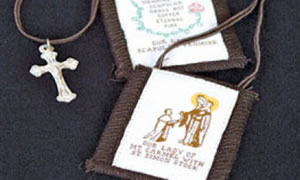


 Ask your Catholic friends what a scapular is, and you’ll get a variety of responses:
Ask your Catholic friends what a scapular is, and you’ll get a variety of responses:
“It’s a sacramental that comes with promises.”
“You wear it to show devotion to Mary.”
“One of those things on strings.”
“Doesn’t it have something to do with your shoulders?”
All these responses are accurate. But let’s unpack them a bit to increase our understanding of this sometimes misunderstood devotion.
In contemporary usage, a scapular (from the Latin for “shoulder blade”) refers to a sacramental object made of two small panels of woven wool (the required material), each roughly two inches by three inches, and connected by a loop of string. The scapular is worn with one panel resting over the breast and the other in approximately the same position on the back.
Where did this sacramental come from? How is it to be worn? And what about those promises? What exactly does a scapular do for its wearer?
Origins
The first scapulars were actually work clothes, worn by monks and later refined into a Religious habit. St. Benedict adopted a simple apron of the sort worn by farmers and labourers; he initially used the garment for work, thus calling it scapulare propter opera (a covering “on account of work”). It later developed into the Benedictine habit we know today. Similar garments came to be used in other Religious communities.
Eventually, members of Third Orders (groups of laypeople formally aligned with Religious through prayer and specific promises) and confraternities (Church-approved lay associations, guided by Church authority) were accorded the honour of burial in the scapular of their “adopted” Order. Generous financial and spiritual benefactors of Religious Orders also received the privilege.
Over time, the practice shifted to what we see today: A small woolen scapular is available to anyone who wishes to wear it.
Regulations
There are specific regulations for wearing a scapular, including “investment” (the blessing of the scapular by a priest) and, if applicable, enrolment in a confraternity, which must be done by a priest with the authority to enrol. Investment can be as simple as a priest’s recitation of the appropriate and applicable prayers, along with a blessing. This blessing is required only for one’s first scapular.
Scapulars must be made of wool and must be worn constantly (though they may be removed for short periods of time). Worn-out or damaged scapulars should be buried or burned (as with any sacramental), and subsequent scapulars need not be “reblessed.”
Alternatively, it’s also acceptable to wear a scapular medal, which must be blessed along with the wool scapular it is replacing. The medal must have the images of Jesus and his Sacred Heart on one side, and the Blessed Mother on the other.
Perhaps the most popular scapular is that of Our Lady of Mount Carmel, or the “Brown Scapular.” Wearing the Brown Scapular expresses devotion to the Mother of God, trust in her intercession, submission to her spiritual maternity, and a desire to emulate her faithfulness. In return, wearers may hope, in faith, to receive the privileges and promises associated with the wearing of the scapular.
Occasions Of Grace
As with any sacramental, a scapular does not offer magical protection. But it can be spiritually powerful, due to the blessings bestowed on it through the Church’s intercession. Sacramentals, which both symbolize holiness and actually become holy through the blessing they receive, dispose us to receive graces.
Wearing a blessed scapular indicates, first and foremost, the conscious effort of one who is motivated to live as a true disciple of Christ. In this way, a scapular offers many occasions of grace. It acts as a reminder to pray regularly, to ask the intercession of the Blessed Mother, and to live a faith-filled life. What it cannot offer is an unconditional guarantee of salvation.
What, then, do a scapular’s promises mean? The Brown Scapular, for example, carries with it the promise (traditionally believed to have been made by Mary in an apparition to St. Simon Stock) that “he who dies in this will be saved.” It also offers us the Sabbatine Privilege, or the assurance that a properly disposed wearer will benefit from the Holy Virgin’s intercession, especially on the Saturday (thus “Sabbatine”) following one’s death.
“Properly disposed” is a key phrase here. Regarding sacramentals, the Church has always taught that one must be properly disposed for them to be effective.
While it’s true that a sacramental is made objectively holy by its transformed nature (having become a blessed object), it’s also true that blessings don’t operate in a vacuum. God uses them, in cooperation with our will, to impart grace. But if we’re unwilling, they can become meaningless.
If my doctor advises me to cut out sugar, walk regularly, and take my medicine, I’d be presumptuous to down milkshakes for breakfast, crawl slothfully through my days, and expect the medicine to compensate for my omissions. Similarly, I cannot expect a scapular to compensate for what I’m unwilling to contribute to my spiritual health.
The scapular is a time-honoured and powerful devotion that asks its wearers to live out the faith they profess. The “medicine” can’t work if we’re working against it, so we should never exercise presumptuous expectations. But if we wear a scapular out of genuine love for Christ and a deep desire to be with Him in eternity, we can hope, in faith, that our expectations will be fulfilled.
In that sense, the privileges associated with that “sacramental thing on strings” are genuine promises. They are the assurances of things hoped for, but not yet seen. CD
This article originally appeared in The Catholic Answer, a publication of Our Sunday Visitor Publishing Division. Karen Edmisten is a freelance writer whose first book, How to Pray the Rosary, will be published by Servant Books in 2009. Her other work may be found online at karenedmisten.com.
The Scapular Devotion Of John Paul II
Pope John Paul II, who is reported to have worn a brown scapular since he was a boy, insisted doctors not remove his scapular during surgery following the assassination attempt in May 1981. Father Mariano Cera, a Carmelite priest, told Inside the Vatican magazine: “Just before the Holy Father was operated on, he told the doctors, ‘Don’t take off the scapular.’ And the surgeons left it on.” In his message to the Carmelites at the 750th anniversary of the bestowal of the scapular, Pope John Paul II said those who wear the scapular - or habit, as he called it - dedicate themselves to the service of Our Lady for the good of the whole Church. “Devotion to her,” he continued, “cannot be limited to prayers and tributes in her honour on certain occasions, but must become a ‘habit,’ that is, a permanent orientation of one’s own Christian conduct, woven of prayer and interior life, through frequent reception of the sacraments and the concrete practice of the spiritual and corporal works of mercy.”


I have been thinking a great deal about my experience at Reconciliation this past Saturday. I felt an intense and unexplainable urge to go and confess my sins when I woke up that morning. I try to go every six weeks or so, but this was no routine visit to the priest for me. I needed to unburden myself of the numerous venial sins I had committed since I last participated in this Sacrament.
Purest Gold: God's Refining Fire in our Lives »
After salvation, many young Christians wonder if there's anything more to their newfound faith than just the security blanket of "being a Christian." Time and time again, God shows himself as a "refiner," and our lives are as gold. God started leading me in this study to understand what He was doing in my life, as well as in the lives of others.
Picking up my pen to write this column, I couldn’t imagine how time flies. Since the last publication of this column I have gone through a lot, especially the loss of my dear mother to whom I dedicate this article. Not only her, but seems I lost a whole generation of my close family.
How to Achieve Business Excellence »
“Do you see a man who excels in his work? He will stand before Kings; He will not stand before unknown men.” Proverbs 22:29
Spiritual Development for our Youth »
Most of us youth in today's fast moving world are easily thrown off by difficulties and worries.
The theme of conversion is a thread that runs all through Lent, but conversion takes on different aspects throughout the phases of Lent. The first two and a half weeks focused on the interior turning of hearts; the liturgy urges the faithful to reflect and examine consciences thoroughly.
Saint Josephine Bakhita »
Feast Day: February 8
Patron Saint Of: Sudan
Saint Josephine Margaret Bakhita was born around 1869 in the village of Olgossa in the Darfur region of Sudan. She was a member of the Daju people and her uncle was a tribal chief. Due to her family lineage, she grew up happy and relatively prosperous, saying that as a child, she did not know suffering.
Catholics Must Fast More Intensely This Lent»
The Norbertine Canons of St. Michael's Abbey have created this digital Lenten retreat so that you can journey through this holy season alongside them. If you want to have one of your best Lenten seasons yet, join us in our Lenten Program "The Great Fast" - https://theabbotscircle.com/the-great-fast-join
When Your Faith Is Put to the Test - Bishop Barron's Sunday Sermon»
Friends, we come now to the Second Sunday of Lent, and we’re on both dangerous and very holy ground with the first reading from the twenty-second chapter of Genesis. The ancient Israelites referred to it as the “Akedah,” which means the “binding”: Abraham binds and is ready to sacrifice Isaac at God’s command.

Copyright © 2002-2024 THE BEACON INTERNATIONAL CATHOLIC MAGAZINE. All rights reserved.
another mc.rufus interactive web design